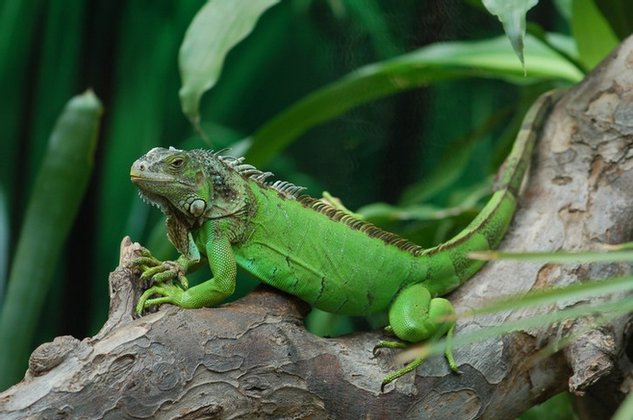Why removing invasive species matters
As an island, Statia is fragile because of its small and isolated ecosystem. It lacks the buffers (e.g. higher diversity of plants and larger animal populations with a higher capacity to recover after disasters) that larger ecosystems have. For this reason, conservation and sustainable management are even more critical.
Invasive species are plants and animals that do not belong to Statia’s natural environment and cause harm to local ecosystems. They compete with native species for space, food, and water, and can quickly overtake fragile or degraded habitats.
On Statia, invasive species include Corallita, the Cuban treefrog, the invasive Green Iguana, feral animals such as chickens, the giant African land snail, lionfish, and rats. Each of these species puts pressure on the local environment in different ways ,from covering hillsides and blocking the growth of native trees to threatening fish stocks and fragile coastal ecosystems.
At the same time, domesticated animals such as livestock and pets can become invasive and a nuisance if animal husbandry practices are not properly executed, resulting in the animals becoming feral. A well-known example of such an animal is the red-eared slider turtle. This turtle is native to North America and Mexico but was widely sold as a pet. Currently, it is considered a significant threat to native turtle species in countries such as Australia and India, as it competes for food with native turtles and invades water bodies where native species live.
On Statia, examples of domesticated animals that have become invasive include goats and chickens. Currently, part of their population on the island is considered livestock, and part is considered feral. The feral population of goats and chickens poses a threat to the ecosystem and to native animals and plants. While goats and chickens as livestock are part of Statia’s agricultural heritage, feral goats and chickens prevent fruit trees, crops, and native plants from growing, damaging natural areas. This creates a ripple effect that reduces local food security and threatens native wildlife through food and habitat competition. Proper livestock management, already being advanced through the Strategic Action Plan for Sustainable Agriculture (SAPSA), ensures that goats and other livestock can contribute positively to food security without harming the island’s environment.
Supporting native species and restoring balance
Removing invasive species gives local plants and animals the chance to thrive. Species such as the bridled quail-dove, the Statia morning glory, the red-billed tropicbird, and the lesser Antillean iguana are unique to the region and require healthy habitats to survive. Protecting these species is not just about preserving nature; it is about maintaining a balanced environment that supports clean air, fresh water, fertile soil, and a resilient local food system.
For example, reducing Corallita allows native trees and bushes to grow back, stabilising the soil and preventing erosion. Controlling lionfish helps restore reef health and protects fish populations important for food security. Managing feral roaming animals ensures fruit trees, crops, and native plants can grow again, providing food for both people and wildlife.
Health and ecological benefits
From both a health and ecological perspective, tackling invasive species helps create a cleaner, safer, and more resilient environment for everyone. Invasive plants and animals can contribute to the spread of pests and diseases, contaminate water sources, and reduce the availability of nutritious local food.
For example, rats and mosquitoes thrive in degraded habitats and can spread illnesses to people and livestock. Overgrown Corallita creates damp conditions that attract pests, while the giant African land snail can damage crops and carry parasites harmful to humans and animals. Feral chickens and goats that roam freely can spread parasites and bacteria through their droppings, contaminate gardens and public areas, and damage crops, which increases pest problems and reduces the safety and quality of locally grown food.
Restoring native vegetation improves air and water quality, reduces disease-carrying pests, and supports healthier living conditions. In this way, protecting Statia’s biodiversity directly benefits the health and well-being of its people.
Responsible and effective management methods
The NEPP works with both local stakeholders and international experts to ensure that invasive species management is guided by scientific knowledge and local experience. Management plans and efforts differ between various species of plants and animals.
For plants such as Corallita, targeted clearing and habitat restoration are part of ongoing efforts. For animal invaders, including the Cuban treefrog, Green Iguana, feral chickens, and lionfish, the NEPP collaborates with specialists to assess each situation and apply appropriate, evidence-informed responses suited to the species and location.
In addition to removing invasive species already present, measures are being taken to prevent new invasions. A biosecure fence will be placed at the harbour and the airport to reduce the risk of new species arriving and spreading on the island.
By combining expert knowledge with local experience, and by taking both preventive and corrective action, Statia is working step by step to restore balance, protect native species, and secure the long-term health of its ecosystems.
Beyond the environmental and health reasons, tackling invasive species also makes financial sense. Preventing and controlling invasive plants and animals reduces damage to crops, infrastructure, and public areas, saving the community money over time. A healthy natural environment supports tourism, strengthens local food production, reduces the need for imports, and prevents costly emergency measures such as repairs to buildings, fences, power lines, and roadsides.
Community engagement and shared responsibility
The Statia Government calls on all community members, farmers, and animal owners to participate actively in protecting our ecosystem. Training on livestock management — such as fencing, pen preparation, improved feeding practices, and better animal health management — and clear guidance are available to ensure that everyone can benefit from the programmes in place.
Together, Statia can restore its unique environment, strengthen its economy, and ensure a healthier and more secure future.
To learn more about the available training and other resources, please contact the Department of Agriculture and Veterinary Services at +599-318-2757.
To learn more about the Nature and Environment Policy Programme, please click here:
